Style Systems: the good, the bad and the hella confusing...
Kibbe, color seasons, and some other options that I like better.
Anyone interested in style has most likely run into a style system, aka some kind of guideline or set of archetypes that one can locate themselves within, which normally comes with a set of recommendations of what will suit them. There are plenty out there but today, I am focusing on the body typing system created by David Kibbe via his book Metamorphosis (1987, there has since been an updated book) and color season analysis, which entered the zeitgeist via the books Color, the Essence of You (1980) by Suzanne Caygill and Color Me Beautiful (1984) by Carole Jackson.
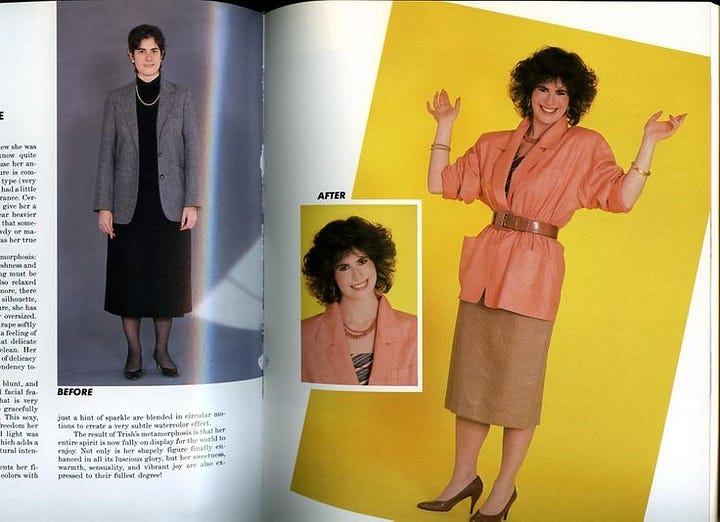
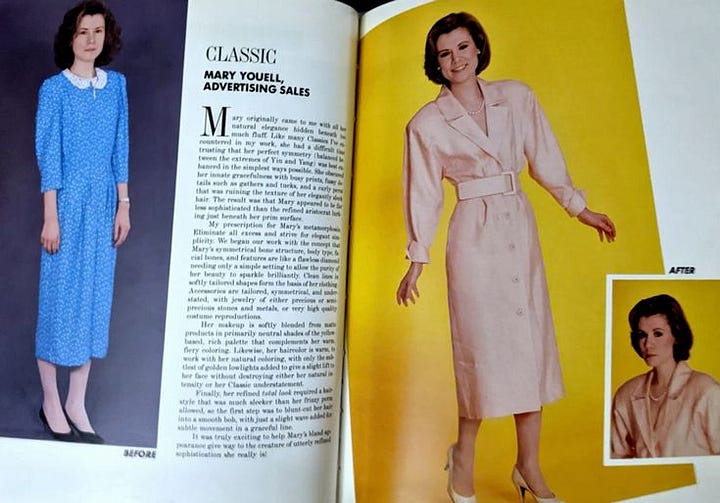
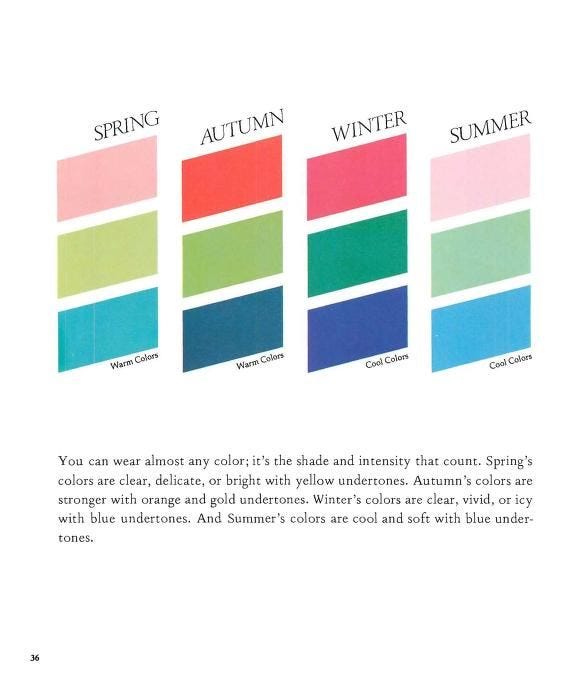
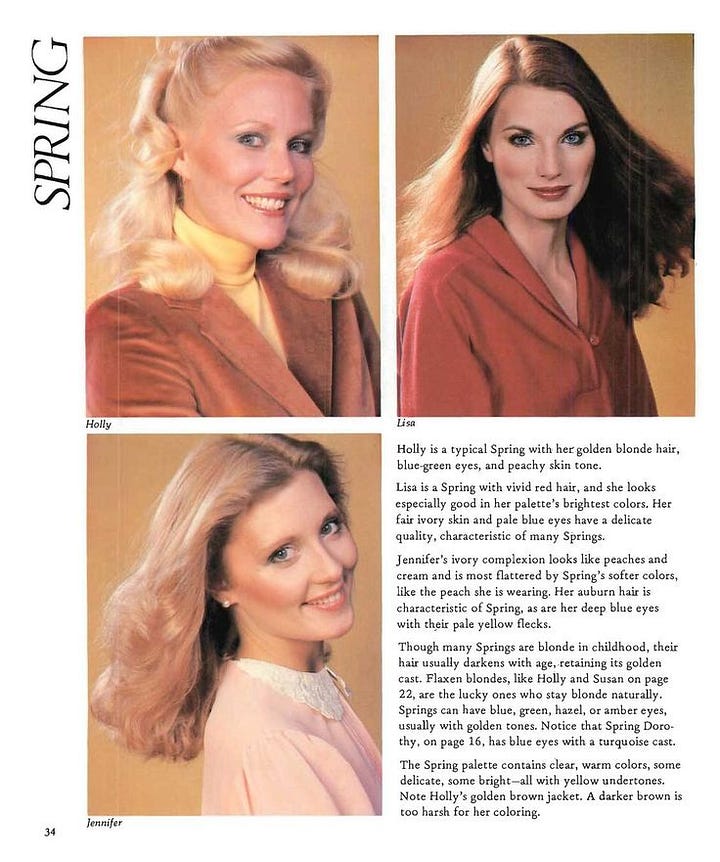
In brief, the Kibbe system involves 10-13 types (he has made edits in recent years) that span a scale of ‘yin and yang energies’. These energies are innate in each of us and our balance of yin and yang manifests both physically and in our ineffable ‘vibe’. The types are developed from his experience as a stylist, and he uses the way leading ladies were cast in classic Hollywood films to create the visual recommendations for each type. For example, Katherine Hepburn is an archetypal ‘dramatic,’ all sharpness and assertiveness (yang), while Marilyn Monroe is a ‘romantic,’ all softness and sensuality (yin). You supposedly can use his guidelines to find yourself on the scale and your associated type to find the personal styling that best suits your shape and personality.
Color seasons are a way of categorizing what colors are supposedly most flattering for different skin tones, or a combination of skin tone, hair color and eye color, organized into the four seasons, and oftentimes with subcategories within them, like ‘soft autumn’ or ‘bright spring.’

Though both books were published in the 1980s, they’ve both gained a life of their own on the internet in recent years, Kibbe especially. I know I was not the only one who found themselves wiling away the hours during lockdown trying to learn his complicated system, mostly in effort to see which sewing patterns might suit whatever type I supposedly am (spoiler, I never really figured it out once and for all). It makes sense that sewists in particular might be interested in these types of structured recommendations, because we have so many options and any sort of shortcut to narrowing them down could, in theory, be a godsend. Know thyself first, then sew accordingly, right?
There is a ton one could say on this topic and I will try not to wander down too many philosophical side streets, but to say I have mixed feelings in an understatement. Style systems bring up so many questions that get to the deeper heart of style as self-expression: While restrictions are generally helpful to creativity, how helpful are prescriptions for getting dressed, really? How do we balance accepting who we are with the power to become whatever we imagine? Who do we dress for? Who gets to decide what looks good? There are no easy answers; forgive me my thoughts are a bit confused as I recover from vacation brain!
The Kibbeverse: the good
First and foremost, I do find Kibbe to be a huge improvement on the ‘apple vs. pear vs. whatever other inanimate object' idea that was ingrained in me as a young person. The fact that it is focused so much on honoring your own body’s lines, rather than trying every trick to look more like a tall hourglass, is fantastic.
Despite everything, I ultimately found that I am glad I learned about the Kibbe system… except not exactly for the reasons it was intended for. If you remove the whole goal of finding your type (which is definitely supposed to be the point), it is an interesting bit of late 20th c. culture from someone who obviously understands classic Hollywood films and how typecasting worked, along with the key principles of design and visual communication. It’s been a tool of understanding the bigger picture of how people’s physical builds, as well as their energetic ‘vibes,’ suit different clothing silhouettes and overall visual presentation.
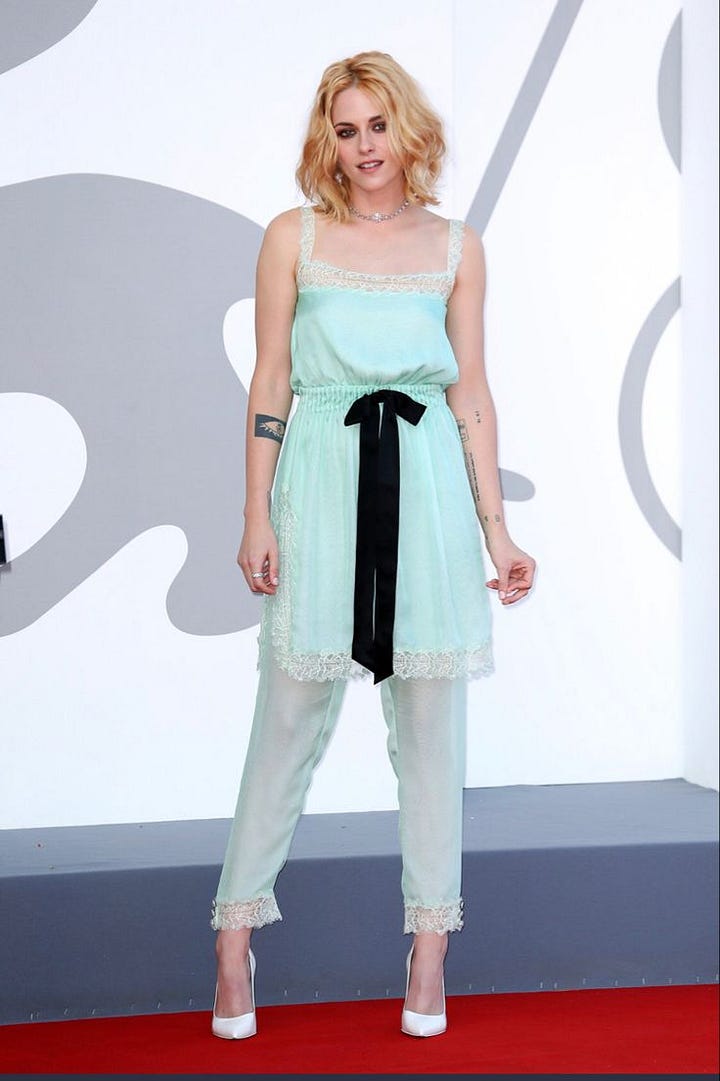

But honestly, doesn’t all of that make more sense for someone who dresses multiple people and needs to create specific effects, aka a designer and/or stylist? You could go down a line of models for a runway show and note, this person has sharper lines so they get the blazer, this one has soft and round features so put them in the drapey knit, etc. There’s also a reason that celebrity red carpet images get used again and again as examples; it makes mismatches of type and clothing choice very apparent, all in a high stakes circumstance. But since none of us are celebs (unless you are, in which case… hi?) and we know the many layers of our own personalities, I think trying to fit yourself into one of these types can be too difficult to be worth it.
Maybe that’s somewhat of the crux here, though I understand David follows the system for dressing himself, all of these systems are made by someone looking at other people. Getting into the Kibbeverse has really helped me in giving style advice to friends and family, as well as developing some range as a designer in being able to envision different customers and what might suit them.
The Kibbeverse: the bad
One of my biggest issues with both Kibbe and color seasons is that they are not representative of the diversity of the real world, which unfortunately makes sense considering their mainstream 1980s white American origins. There tends to be a lot of different options for white folks, while people of color tend to be stuck into a few limited categories (if they are included at all). And most of the examples, even those used by people who create new content, are of thin, white, cis women celebrities. Aren’t we just propping up oppressive ideals, while discounting the diversity of both bodies and tastes in this big old world? Not to mention for Kibbe in particular, it is both created by a man and based on an industry which inspired the term ‘the male gaze!’ I understand there have been updates in body and racial diversity in the new Kibbe book, but the examples are all still cis women. (Thanks to Hannah Louise Poston’s vid below for filling me in on the updated book!)
Along with the lack of diversity, the physical self-analysis involved with Kibbe can easily become a playground for picking yourself apart, and anyone who tends towards any kind of dysmorphia should tread very carefully. In all fairness, I have also heard from people that it has helped them enormously with their body image, so the jury is still out, I suppose!
I recall I did do the quiz in the original book and the result was ‘theatrical romantic,’ which I don’t think is accurate at all. I remember once having a casual conversation with someone on IG about Kibbe, and when I said what I thought my type might be (soft dramatic), she immediately disagreed with me. This was unreasonably annoying. On an individual level, that is perhaps the biggest issue, it’s just plain confusing! The amount of debate I’ve seen online about whether a celebrity is one type or another is a little bit odd to be sure, but also derives from the fact that it’s not straightforward enough. Perhaps the goal of encompassing everyone in the world with any system is too lofty? Food for thought.
More modern approaches
I recently took a photography class with the excellent teachers Alan Meader and Gary Sanders, and I really appreciated how they discussed the ‘rules’ that traditionally come with photography (eg. the rule of thirds). It was with the caveat that these aren’t actually rules. They are a simplified version of many years of collected wisdom around what the human eye tends to be drawn to. It’s how our brains and intuition try to make sense of whatever visual input we’re receiving. I definitely think this can be applied to clothing design and styling; we can’t consciously take in every detail of an outfit in an instant, we just get an impression looking at the whole.
Along these lines, I do think one effective way to evolve the conversation over what looks good or flattering is to not think of style systems as a set of rules, but rather visual communication tools. A style system creator that has built off of Kibbe, color seasons and other systems who I enjoy is Ellie-Jean Royden. She often uses the word ‘harmonious’ in describing the result of dressing for your type, which I see as a more evolved version of ‘flattering.’
The concept is simple: echoing the lines of your body in the silhouette of your clothes tends to look harmonious. Wearing lines that contradict your natural shape looks less harmonious, which, as described in one of her best videos above, can be harnessed for a specific effect. Neither approach is good or bad, both are methods to create the impression you want to create.
Another creator who has done a great job building on older systems and perhaps has my favorite one of all is Style Thoughts by Rita. I love that she starts from what she calls style logic, essentially looking at what motivates you to get dressed, which not nearly enough people talk about. Do you think more about the circumstances you are getting dressed for or how you are feeling that day? It’s a question of external vs. internal motivation.
I’ll let her universe speak for itself, but I will say this woman really gets it! I also had the pleasure of working with her via a style analysis video call as a graduation present to myself; she is very intuitive and it was kind of like a lighthearted psychic reading along with determining my place in her four-quadrant system, as well as giving fun outfit suggestions. I may go more into that experience in the future if folks are interested.
Color Seasons: I’ll pass…but you could try this instead!
For brevity’s sake and because I am less experienced with color seasons, I’ll keep this section short and focus on my own personal color palette technique. While I certainly understand warm vs. cool vs. neutral tones, paying attention to undertones and overtones, etc., I found trying to locate myself or anyone else within the seasons and sub-seasons to be more trouble than it was worth, especially with the lack of diversity of skin tones in the original concept. Another layer here is there are a decent number of folks out there making money color typing people; some folks have said it changed their lives, while others call it a scam. A topic for another day, perhaps??
Again born entirely out of lockdown boredom, here is how I created a personal color palette that can free you from needing to fit into any category:
Get a good picture of yourself in natural lighting and carefully adjust the levels to look as close to real life as you can.
Use a color picker to get the Hex codes of the following places, trying to get as ‘average’ of a color for each area as you can.
1-3 shades of your skin tone. Often people have a different tone on their jaw area to their cheeks, and their body.
The most predominate color of your hair.
Your iris.
Your natural lip color.
Then input two or more of these into a color palette generator like Adobe Color to see what your suggested complimentary/analogous/split complementary colors. Adjust as desired, and use Canva to create a palette of your favorites. Et voilà!
Though there are a lot of nuances to colors that a flat swatch can’t necessarily capture, I have found this method to work pretty well, especially if you are shopping for fabric or makeup and are faced with the same option in a bunch of different colors. I don’t stick to the palette strictly by any means, it’s more of a guardrail for when I’m feeling indecisive.
Makeover culture and takeaways
To me, style systems in part represent our desire for objectivity. If only we could see ourselves the way others do, especially someone with a trained eye, it would be so obvious what suits us. We want to be able to clear away the clutter of our own complicated relationships with ourselves and how we look. Anyone around my age also grew up with a ton of makeover narratives and scenes in movies and tv (Luxeria and Roly on YT have some hilarious rewatch videos of the original What Not to Wear) and we’ve been taught to desire some kind of transformation brought on by someone wiser. Of course, there’s also Pygmalion and all of that, so I suppose it’s not a modern phenomenon!
Personally, I think the best of what a makeover can do for someone is to bring out some aspect of someone’s inner life that they feel disconnected to and make it more obvious. To paraphrase an example in the book Tim Gunn’s Guide to Style: take someone who feels stuck in an office wear rut, but used to dance, and still goes to the ballet every weekend. All she would need to do is switch out her pencil skirt for one with some soft movement, perhaps in a ballet pink, then all of a sudden her coworkers are able to see more of who she is (even if they don’t consciously register it). Though I understand in the Kibbeverse that someone without the ‘correct’ features for such a skirt might not look their ‘best’ in it, for me, it would be more important that she allow her true self to be more seen.
“What the artist is always looking for is the mode of existence in which soul and body are one and indivisible: in which the outward is expressive of the inward: in which form reveals.” -Oscar Wilde
I hope to see more style contemporary experts building on these older systems taking more into account of who someone is on the inside, while maintaining the design principles that make the proportion guidelines useful, if you choose to follow them. And within that choice lies your power.
What do you all think? Kibbe in particular seems to generate some strong opinions and I’m curious if you’ve run into any of these niches online! Do you have another system or style creator you recommend?
As always, any unlinked/uncredited images can be found on my Pinterest. À bientôt, tout le monde!



